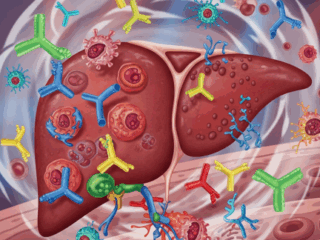
The liver is responsible for blood filtration, the production of proteins and enzymes, storing nutrients, and food digestion. However, alcohol consumption, chronic viral infections like hepatitis B or C, non-alcoholic fatty liver disease, autoimmune liver disease, and genetic or metabolic disorders lead to the buildup of scar tissue (fibrosis). As a result, it disrupts the normal structure and function of the liver. This can further lead to serious complications, including liver failure, portal hypertension, fluid buildup in the abdomen, and even liver cancer.
The symptoms of cirrhosis may not appear in early stages, but patients may experience fatigue, jaundice, swelling in the legs or abdomen, etc. Early detection and management can slow down the disease progression and prevent life-threatening diseases. Here is where polyclonal antibodies come into play.
What is the Definition of Polyclonal Antibodies?
Polyclonal antibodies (pAbs) are a heterogeneous mixture of antibodies produced by different B-cell clones. These antibodies are designed to identify and bind to multiple epitopes on the same antigen. So, pAbs are known for their versatility and sensitivity. They can recognize proteins, antigens, and antibodies in a biological sample even if their concentration is very low.
Researchers often use pAbs in cirrhosis research to identify and study different antigens in a sample.
For instance, Horse HBsAg polyclonal antibody is used in liver disease research to detect hepatitis B surface antigens, which are critical markers in viral hepatitis—a major cause of cirrhosis.
pAbs target multiple epitopes of the same antigen. As a result, they provide more reliable detection, even when antigen levels are low. This allows researchers to study the early stages of liver damage effectively.
Role of pAbs in Cirrhosis Research
Detect Liver Biomarkers
Different biomarkers are produced by the liver during liver dysfunction. It includes Alpha-fetoprotein (AFP) and Albumin. Our liver also releases enzymes such as ALT and AST into the blood when liver cells are damaged. Abnormal levels of these biomarkers and enzymes indicate liver damage. So, researchers look for these biomarkers using pAbs to understand liver function and disease progression.
Since pAbs can bind to multiple regions on these proteins, they enhance detection sensitivity. So, pAbs play a vital role in the early detection of cirrhosis and allow researchers and clinicians to take necessary steps to manage the disease.
Study Fibrosis and Extracellular Matrix Proteins
During cirrhosis, fibrosis is common. In this condition, the excessive accumulation of extracellular matrix proteins, such as collagen, fibronectin, and laminin, occurs. Fibrosis replaces healthy liver tissues with scar tissue and impairs liver function.
pAbs help study these proteins. Researchers use pAbs to stain liver tissue samples and visualize the distribution of collagen and other fibrotic components. Their ability to bind to multiple epitopes ensures reliable detection. Based on the results, researchers can further quantify the fibrosis, understand its progression, and evaluate the effects of potential therapeutic interventions.
Monitor Immune Responses
Cirrhosis often comes with long-term inflammation in the liver. The immune system can become overactive or unbalanced, which can make liver damage worse. Polyclonal antibodies help study this immune activity. They can detect immune cells, proteins, and signaling molecules called cytokines that play a role in inflammation.
For example, two important cytokines in cirrhosis are tumor necrosis factor-alpha (TNF-α) and interleukin-6 (IL-6). These molecules cause inflammation and help trigger fibrosis, the scarring of liver tissue. Polyclonal antibodies can bind to many parts of these cytokines, making it easier to detect even small amounts.
By measuring the levels of these immune molecules, researchers can see how inflammation develops in the liver. They can also learn which immune signals are most harmful. This knowledge helps scientists find targets for new treatments, such as drugs that reduce inflammation or therapies that adjust the immune response to prevent further liver damage.
Evaluate Potential Therapies
Finding effective treatments for cirrhosis is challenging. Researchers need to know if a new drug really helps the liver. Polyclonal antibodies are used to track changes in proteins and tissue in response to these drugs.
For example, fibrosis involves excess collagen in the liver. Polyclonal antibodies can detect collagen and other proteins in liver tissue. In drug studies, researchers can compare collagen levels before and after treatment. A decrease in collagen shows that the drug may be reducing fibrosis.
Polyclonal antibodies also help study hepatic stellate cells, which are the main cells responsible for liver scarring. These antibodies can detect whether the cells are active or inactive. Tracking these changes gives researchers important information about how well a therapy works.
The Bottom Line
Now that you know how pAbs aid in cirrhosis research, what are you waiting for? Find a reliable supplier to buy high-quality pAbs and start your research now. Choosing high-quality antibodies is essential for reliable and reproducible results.












